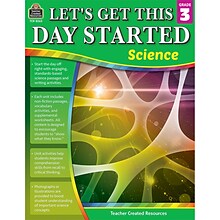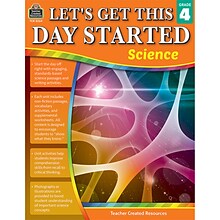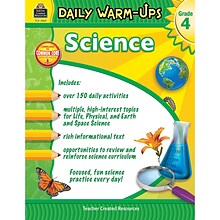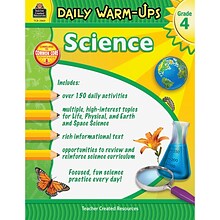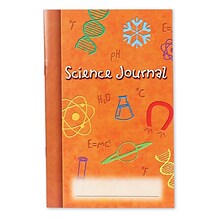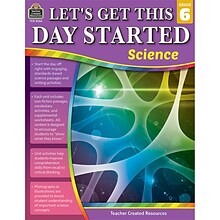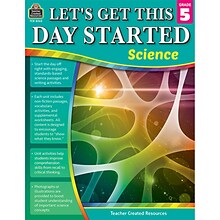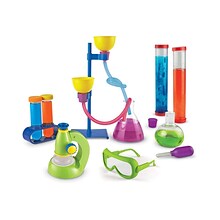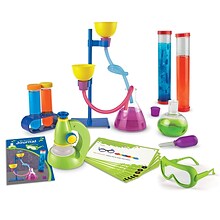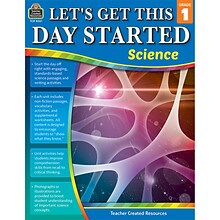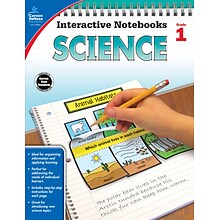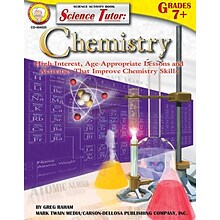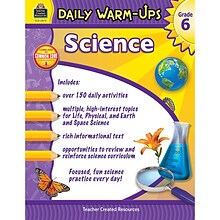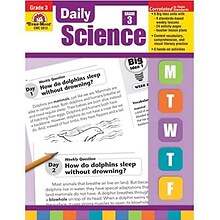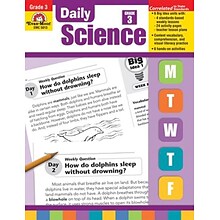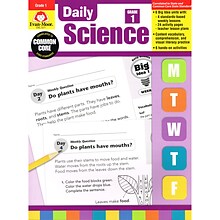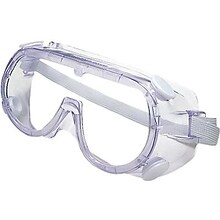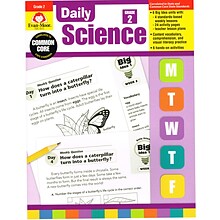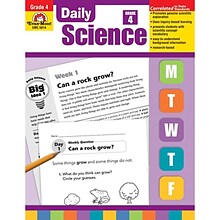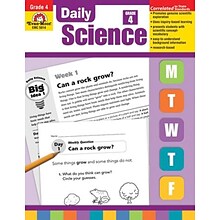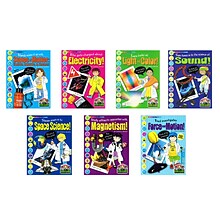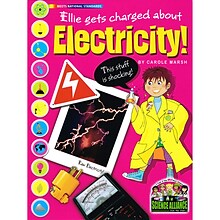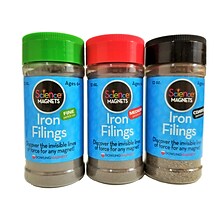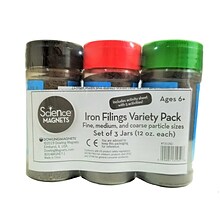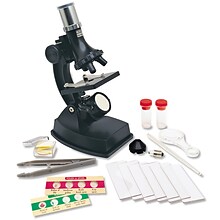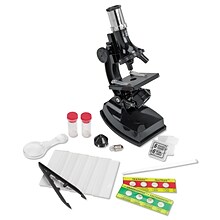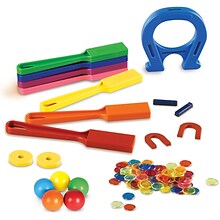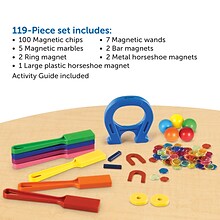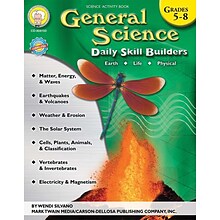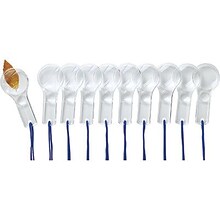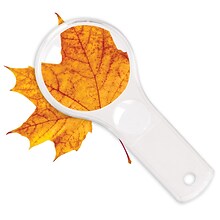Shop science resources
(399 items found)
Sort by:
Best match
Teacher Created Resources Lets Get This Day Started: Science Workbook for Grade 3 (TCR8263)
Item #: 901-24439151
Paperback workbook with 112 pages
Everyday science skills for ages 8-9 years
Includes 1 science workbook
$16.89
Per each
Teacher Created Resources Lets Get This Day Started: Science Workbook for Grade 4 (TCR8264)
Item #: 901-24439139
Paperback workbook with 112 pages
Everyday science skills for ages 9-10 years
Includes 1 science workbook
$15.89
Per each
Teacher Created Resources Daily Warm-Ups: Science Grade 4 Education Printed Book for Science, Book, 176 Pages
Item #: 901-JV2696328
Daily activities provide opportunities to review and reinforce curriculum
Quick, simple format encourages students to complete each activity
Grade-appropriate material is correlated to Common Core State Standards
$21.79
Per each
Learning Resources Science Journals, Multicolor, 10/Set (LER0389)
Item #: 901-JV51761
Age group and grade: Ages 5 - 7 and grades kindergarten+
Type: Journal
32 page journals feature half blank/half lined pages on the left side so students can both draw and explain their explorations
$18.69
Per set
Teacher Created Resources Lets Get This Day Started: Science Workbook for Grade 6 (TCR8266)
Item #: 901-24439167
Paperback workbook with 112 pages
Everyday science skills for ages 11-12 years
Includes 1 science workbook
$15.89
Per each
Teacher Created Resources Lets Get This Day Started: Science Workbook for Grade 5 (TCR8265)
Item #: 901-24439133
Paperback workbook with 112 pages
Everyday science skills for ages 10-11 years
Includes 1 science workbook
$14.69
Per each
Learning Resources Primary Science Deluxe Lab Set (LER0826)
Item #: 901-2662129
Ages: 3+
17.5" x 10.2" x 5.6"
Kids will be excited to explore science with this hands-on deluxe set that features 20 activity cards with step-by-step activities
$52.99
Per each
Teacher Created Resources Lets Get This Day Started: Science Workbook for Grade 1 (TCR8261)
Item #: 901-24439117
Paperback workbook with 112 pages
Everyday science skills for ages 6-7 years
Includes 1 science workbook
$13.59
Per each
Carson-Dellosa Interactive Notebooks Science Grade 1 Resource Book (104905)
Item #: 901-2105265OSA
Carson-Dellosa Publishing 2016
Holly Rafidi
96 pages in Paperback format
$7.59
Per each
Carson-Dellosa Interactive Notebooks Science Grade 5 Resource Book (104909)
Item #: 901-2105261OSA
Carson-Dellosa Publishing 2016
Sara Haynes Blackwood
96 pages in Paperback format
$7.89
Per each
Mark Twain Science Tutor Resource Book, Grades 7+
Item #: 901-805662
Grades 7+
Each lesson contains an “Absorb” section to instruct and simplify concepts, and an “Apply” section to help students grasp concepts
Topics include matter, physical and chemical changes, mixtures and solutions, the periodic table, atomic structure, and radioactivity
$10.09
Per each
Teacher Created Resources Daily Warm-Ups, Grade 6 (TCR3973)
Item #: 901-JV2659156
Informational text about Life, Physical, and Earth and Space science is presented along with 150 activities that can be used to review and/or expand existing science curriculum.
The content is correlated to the Common Core State Standards.
For ages 11.
$18.99
Per each
Featured
Daily Science, Grade 3
Item #: 901-JV42816
Age group and grade: Ages 8 - 9 and grades 3rd
Type: Earth science
A variety of rich resources including vocabulary practice, hands on science activities and comprehension tests in multiple choice format help you successfully introduce students to Earth, life and physical science concepts
$30.79
Per each
Daily Science, Grade 1
Item #: 901-JV42814
Help your grade 1 students explore standards-based science concepts and vocabulary using 150 daily lessons
A variety of rich resources including vocabulary practice, hands-on science activities, and comprehension tests in multiple-choice format help you successfully introduce students to earth, life, and physical science concepts
30 weeks of instruction covers many standards-based science topics
$28.09
Per each
Learning Resources Clear Safety Goggles
Item #: 901-JV34840
Age group and grade: Ages 5 - 17 and grades kindergarten - 11th
Type: Experiments
Durable plastic goggles protect eyes, while flexible body increases wearing comfort
$13.39
Per each
Daily Science, Grade 2
Item #: 901-JV42815
Age group and grade: Ages 8 - 11 and grades 2nd
Type: Earth science
Vocabulary practice, hands on activities and comprehension tests provide everything you need to engage students in science instruction
$33.99
Per each
Daily Science, Grade 4
Item #: 901-JV42817
Age group and grade: Ages 9 - 10 and grades 4th
Type: Earth science
Help students develop a genuine understanding of standards based scientific concepts and vocabulary
$30.79
Per each
Science Alliance Physical Science, Set of all 7 titles (GALSPSAPPHYSKS)
Item #: 901-JV66389
Each book is 32 pages
Grades 2-7
Includes 7 book titles
$54.19
Per set
Dowling Magnets® Iron Filings, Variety, Laboratory Science, Science Resources, Grades 1+, Pack of 3
Item #: 901-24493505
Laboratory Science Resources
STEM/6+ Years
3 Sizes (fine, medium, coarse) jars of iron fillings, STEM activity sheets
$19.09
Per pack
Learning Resources Elite Microscope (LER2344)
Item #: 901-JV44227
Age group and grade: Ages 8+ and grades 2nd
Type: Experiments
This elite microscope is designed for beginning scientists
$28.79
Per each
Teacher Created Resources, Test Tube & Activity Card Set (TCR20722)
Item #: 901-JV2323495
Science test tubes encourage experimentation, observation and analysis
Each test tube holds up to 35 mL (about 1 oz.)
Test tubes are clear plastic
$16.49
Per set
Learning Resources Super Magnet Classroom Lab Kit (LER2064)
Item #: 901-JV38266
Age group and grade: Ages 6 - 11
Type: Game
Use for children magnet lab for doing experiments
$46.69
Per each
Mark Twain General Science Resource Book
Item #: 901-805980OSA
Grades 5 - 8
Provides extra practice with the skills students are learning in their physical, earth, space, and life science curriculums
Activities can be used in differentiated instruction situations and as warm-ups, homework assignments, or extra practice
$10.49
Per each
Learning Resources Dual Lens Magnifiers
Item #: 901-JV38265
Encourage children to compare and contrast items up close with these dual 3x and 6x plastic lens magnifiers
Set of 10
Lens measure 1¾" in diameter
$15.49
Per set
